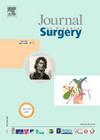Risk factors for local recurrence of rectal cancer after curative surgery: A single-center retrospective study
IF 2
4区 医学
Q2 SURGERY
引用次数: 0
Abstract
Purpose
Approximately 7% of patients with rectal cancer experience local recurrence within 5 years of curative surgery. A positive circumferential resection margin (CRM) is among the most significant risk factors. Other reported risk factors include histopathologic type, anastomotic leakage, positive distal margins, and more recently, the anterior localization of the tumor. In this retrospective cohort study, we aimed to assess risk factors for local recurrence in our institution, with a focus on tumor localization as an independent negative predictive factor.
Patients and methods
From 2007 to 2018, all patients with stage II or III rectal cancer were included in this study. Patients underwent neoadjuvant chemoradiotherapy followed by surgical resection with total mesorectal excision. The tumor's anterior or posterior localization was assessed by preoperative endosonography or magnetic resonance imaging. Risk factors for local recurrence were assessed using univariate and multivariate regression analyses.
Results
A total of 128 patients were included. The 3-year and 5-year local recurrence rates were 4.7% and 7%, respectively. In univariate and multivariate analyses, the histologic type of a poorly differentiated tumor (P = 0.001) and a positive CRM (P = 0.001) were correlated with local recurrence. Tumor localization (anterior or posterior) was not identified as a statistically significant factor associated with local recurrence.
Conclusion
Positive CRM and a poorly differentiated tumor histological subtype were found to be independent risk factors for local recurrence. In contrast to previous findings, anterior localization was not identified as an independent risk factor for local recurrence in our patient cohort.
直肠癌根治术后局部复发的风险因素:单中心回顾性研究
目的:约有 7% 的直肠癌患者在治愈性手术后 5 年内出现局部复发。周缘切除边缘(CRM)阳性是最重要的风险因素之一。其他已报道的风险因素包括组织病理学类型、吻合口漏、远端边缘阳性以及最近出现的肿瘤前部定位。在这项回顾性队列研究中,我们旨在评估本院的局部复发风险因素,重点关注肿瘤定位这一独立的阴性预测因素:从2007年到2018年,所有II期或III期直肠癌患者都纳入了这项研究。患者在接受新辅助化放疗后进行手术切除,并行全直肠系膜切除术。肿瘤的前方或后方定位通过术前内窥镜或磁共振成像进行评估。采用单变量和多变量回归分析评估局部复发的风险因素:结果:共纳入 128 例患者。3年和5年局部复发率分别为4.7%和7%。在单变量和多变量分析中,组织学类型为分化不良肿瘤(P=0.001)和CRM阳性(P=0.001)与局部复发相关。肿瘤定位(前部或后部)未被确定为与局部复发有统计学意义的相关因素:结论:CRM阳性和分化不良的肿瘤组织学亚型是局部复发的独立危险因素。与之前的研究结果不同的是,在我们的患者队列中,前部定位并未被确定为局部复发的独立风险因素。
本文章由计算机程序翻译,如有差异,请以英文原文为准。
求助全文
约1分钟内获得全文
求助全文
来源期刊

Journal of Visceral Surgery
SURGERY-
CiteScore
2.00
自引率
9.50%
发文量
108
审稿时长
>12 weeks
期刊介绍:
The Journal of Visceral Surgery (JVS) is the online-only, English version of the French Journal de Chirurgie Viscérale. The journal focuses on clinical research and continuing education, and publishes original and review articles related to general surgery, as well as press reviews of recently published major international works. High-quality illustrations of surgical techniques, images and videos serve as support for clinical evaluation and practice optimization.
JVS is indexed in the main international databases (including Medline) and is accessible worldwide through ScienceDirect and ClinicalKey.
 求助内容:
求助内容: 应助结果提醒方式:
应助结果提醒方式:


